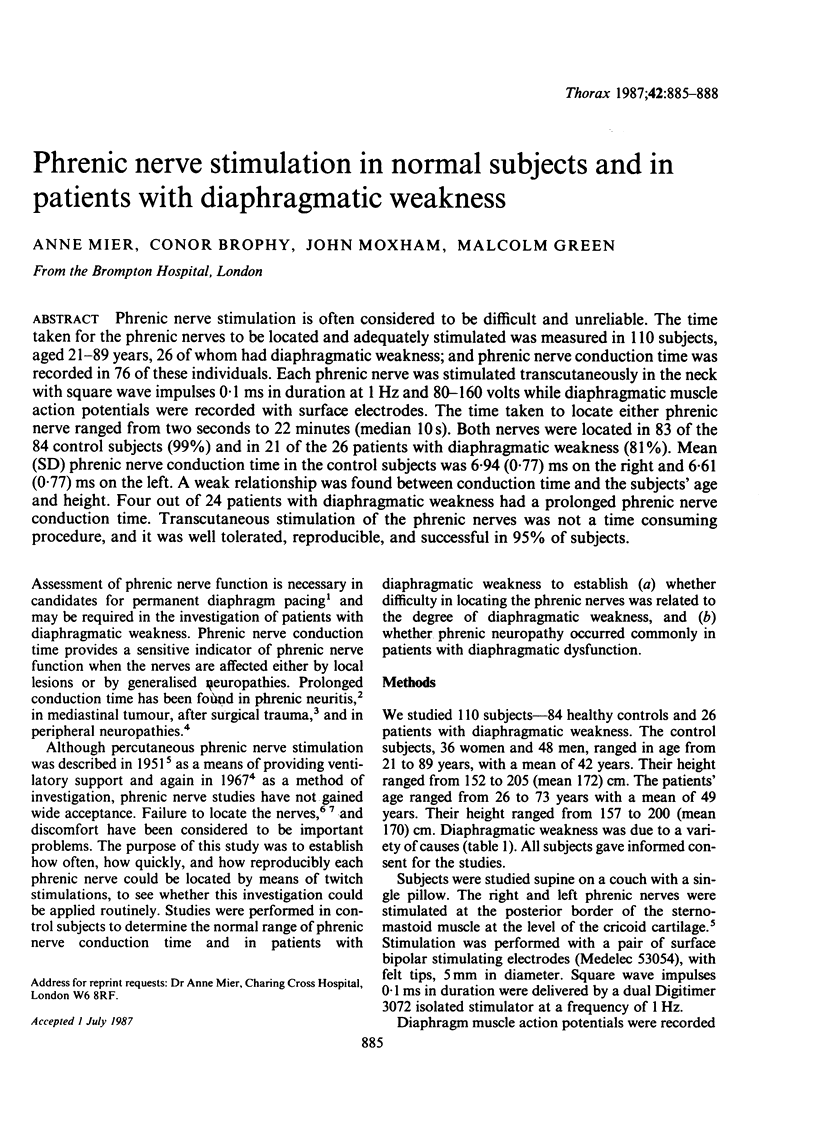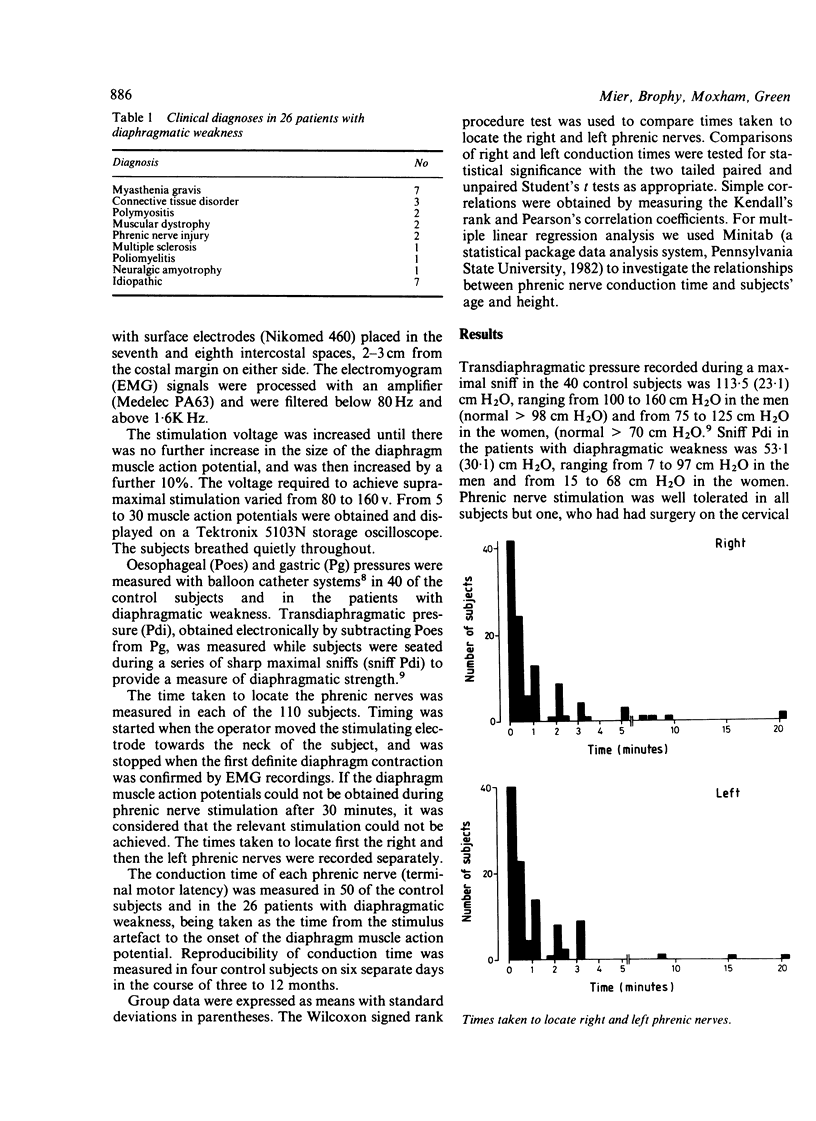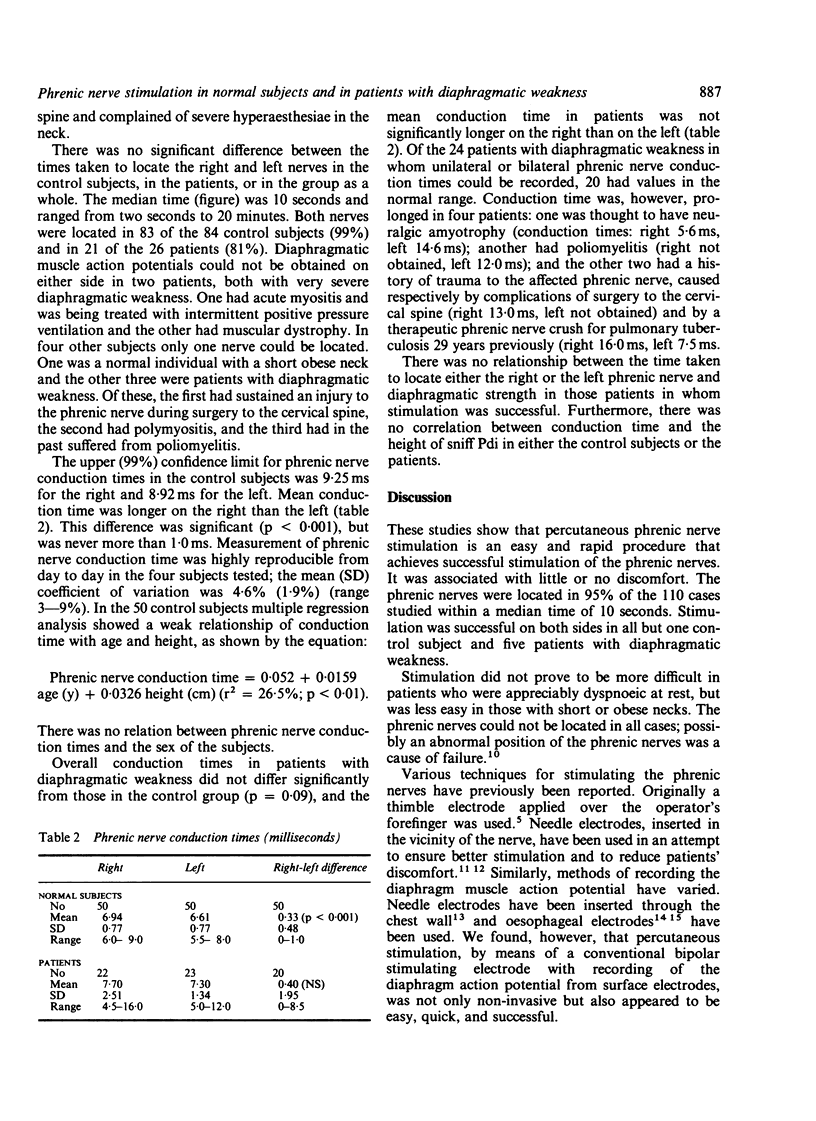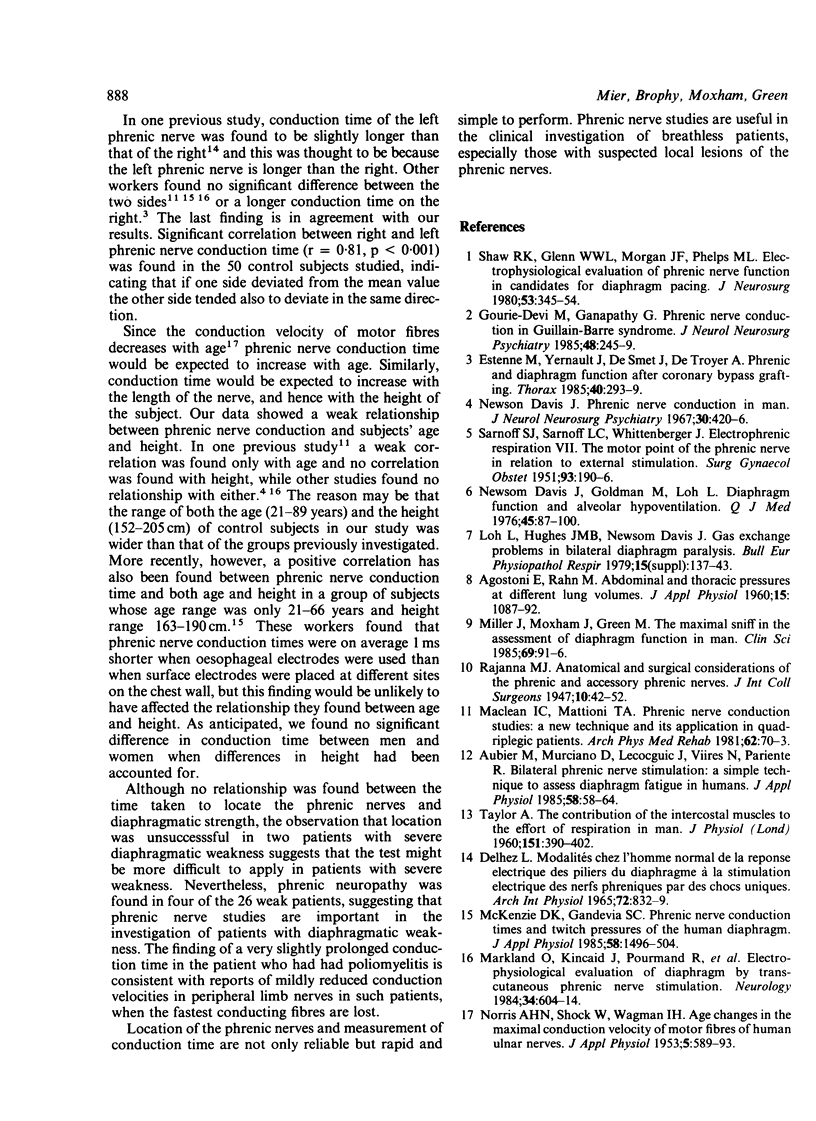Abstract
Phrenic nerve stimulation is often considered to be difficult and unreliable. The time taken for the phrenic nerves to be located and adequately stimulated was measured in 110 subjects, aged 21-89 years, 26 of whom had diaphragmatic weakness; and phrenic nerve conduction time was recorded in 76 of these individuals. Each phrenic nerve was stimulated transcutaneously in the neck with square wave impulses 0.1 ms in duration at 1 Hz and 80-160 volts while diaphragmatic muscle action potentials were recorded with surface electrodes. The time taken to locate either phrenic nerve ranged from two seconds to 22 minutes (median 10s). Both nerves were located in 83 of the 84 control subjects (99%) and in 21 of the 26 patients with diaphragmatic weakness (81%). Mean (SD) phrenic nerve conduction time in the control subjects was 6.94 (0.77) ms on the right and 6.61 (0.77) ms on the left. A weak relationship was found between conduction time and the subjects' age and height. Four out of 24 patients with diaphragmatic weakness had a prolonged phrenic nerve conduction time. Transcutaneous stimulation of the phrenic nerves was not a time consuming procedure, and it was well tolerated, reproducible, and successful in 95% of subjects.
Full text
PDF



Selected References
These references are in PubMed. This may not be the complete list of references from this article.
- AGOSTONI E., RAHN H. Abdominal and thoracic pressures at different lung volumes. J Appl Physiol. 1960 Nov;15:1087–1092. doi: 10.1152/jappl.1960.15.6.1087. [DOI] [PubMed] [Google Scholar]
- Aubier M., Murciano D., Lecocguic Y., Viires N., Pariente R. Bilateral phrenic stimulation: a simple technique to assess diaphragmatic fatigue in humans. J Appl Physiol (1985) 1985 Jan;58(1):58–64. doi: 10.1152/jappl.1985.58.1.58. [DOI] [PubMed] [Google Scholar]
- Davis J. N. Phrenic nerve conduction in man. J Neurol Neurosurg Psychiatry. 1967 Oct;30(5):420–426. doi: 10.1136/jnnp.30.5.420. [DOI] [PMC free article] [PubMed] [Google Scholar]
- Davis J., Goldman M., Loh L., Casson M. Diaphragm function and alveolar hypoventilation. Q J Med. 1976 Jan;45(177):87–100. [PubMed] [Google Scholar]
- Delhez L. Modalités, chez l'homme normal, de la réponse électrique des piliers du diaphragme à la stimulation électrique des nerfs phréniques par des chocs uniques. Arch Int Physiol Biochim. 1965 Dec;73(5):832–839. doi: 10.3109/13813456509084906. [DOI] [PubMed] [Google Scholar]
- Estenne M., Yernault J. C., De Smet J. M., De Troyer A. Phrenic and diaphragm function after coronary artery bypass grafting. Thorax. 1985 Apr;40(4):293–299. doi: 10.1136/thx.40.4.293. [DOI] [PMC free article] [PubMed] [Google Scholar]
- Gourie-Devi M., Ganapathy G. R. Phrenic nerve conduction time in Guillain-Barré syndrome. J Neurol Neurosurg Psychiatry. 1985 Mar;48(3):245–249. doi: 10.1136/jnnp.48.3.245. [DOI] [PMC free article] [PubMed] [Google Scholar]
- Loh L., Hughes J. M., Davis J. N. Gas exchange problems in bilateral diaphragm paralysis. Bull Eur Physiopathol Respir. 1979;15 (Suppl):137–143. [PubMed] [Google Scholar]
- Markand O. N., Kincaid J. C., Pourmand R. A., Moorthy S. S., King R. D., Mahomed Y., Brown J. W. Electrophysiologic evaluation of diaphragm by transcutaneous phrenic nerve stimulation. Neurology. 1984 May;34(5):604–614. doi: 10.1212/wnl.34.5.604. [DOI] [PubMed] [Google Scholar]
- McKenzie D. K., Gandevia S. C. Phrenic nerve conduction times and twitch pressures of the human diaphragm. J Appl Physiol (1985) 1985 May;58(5):1496–1504. doi: 10.1152/jappl.1985.58.5.1496. [DOI] [PubMed] [Google Scholar]
- Miller J. M., Moxham J., Green M. The maximal sniff in the assessment of diaphragm function in man. Clin Sci (Lond) 1985 Jul;69(1):91–96. doi: 10.1042/cs0690091. [DOI] [PubMed] [Google Scholar]
- NORRIS A. H., SHOCK N. W., WAGMAN I. H. Age changes in the maximum conduction velocity of motor fibers of human ulnar nerves. J Appl Physiol. 1953 Apr;5(10):589–593. doi: 10.1152/jappl.1953.5.10.589. [DOI] [PubMed] [Google Scholar]
- Shaw R. K., Glenn W. W., Hogan J. F., Phelps M. L. Electrophysiological evaluation of phrenic nerve function in candidates for diaphragm pacing. J Neurosurg. 1980 Sep;53(3):345–354. doi: 10.3171/jns.1980.53.3.0345. [DOI] [PubMed] [Google Scholar]
- TAYLOR A. The contribution of the intercostal muscles to the effort of respiration in man. J Physiol. 1960 May;151:390–402. doi: 10.1113/jphysiol.1960.sp006446. [DOI] [PMC free article] [PubMed] [Google Scholar]


